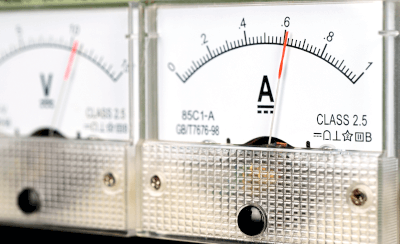What Is a DC Ammeter?
 A DC ammeter is an instrument used to measure the DC current flowing in an electric circuit.
A DC ammeter is an instrument used to measure the DC current flowing in an electric circuit.
A DC ammeter can be roughly divided into two types, which differ in both display form and measurement principle.
- Analog DC ammeter: The meter pointer moves to indicate the current value.
- Digital DC ammeter: The current value is displayed numerically.
The advantage of the analog type is that the swing of the needle provides an overview of the current value at a glance. However, the measurement accuracy is approximately 2.5% for general measurements and around 0.2% for high-accuracy measurements.
The advantage of the digital type is that the current value is displayed numerically, making it difficult to make a reading error. In addition, the measurement accuracy is about 0.2% even for general types, and some claim to have an error of 0.02% for high-precision types.
Uses of DC Ammeters
DC ammeters are used to accurately monitor the power supply status and operating conditions of DC equipment in various facilities and factories. For example, in equipment that uses a DC motor, the current consumption value increases as the load increases. Therefore, if an abnormality occurs, the current value indicated by the ammeter will rise or fall, making it possible to quickly detect it.
Ammeters are also used to verify the operation of electronic circuits to ensure that the current is flowing as designed.
Principle of DC Ammeters
1. Analog Type
The main types of analog DC ammeters used are the movable coil type and the movable iron strip type.
Movable coil type
A coil placed in a uniform magnetic field generates a rotating torque proportional to the current flowing in the coil. A moving-coil type ammeter has a spring and pointer attached to this coil, the position indicated by the pointer indicates the current value. This is the principle of the moving coil type, which is the most common DC ammeter.
Movable iron strip type
Two iron pieces, one fixed and the other rotatable, are placed in the magnetic field generated by the coil through which the measuring current flows, and the torque generated by their repulsion or attraction is utilized. Since it indicates the effective value, it is mainly used for AC ammeters. However, it can also measure DC current with an AC component. Nevertheless, due to the uneven scale, reading the numerical value can be challenging.
Thermoelectric type
This type of ammeter uses a thermocouple to convert the heat generated when the current under test is applied to a hot wire into thermal electromotive force, which is used to move a movable coil. Although it is possible to measure any current from AC to DC, including high frequencies, it has the disadvantages of taking time to measure and being vulnerable to overloads since it is necessary to wait until the temperature rises.
In analog ammeters, a current divider with a resistance smaller than the internal resistance of the ammeter is connected in parallel to measure large currents that exceed the current range specific to the meter. It is possible to widen the measurement range by setting the resistance value so that most of the current flows through the shunt and part of the current flows through the ammeter.
2. Digital Type
The digital type is mainly used for the current measurement range of digital multimeters. A low-resistance resistor is inserted between the power supply unit and the device. The voltage at both ends of the resistor is then measured and converted to a current value.
Since a digital voltmeter is used to measure the voltage, the current value is the result of the calculation (measured voltage ÷ resistance of the resistor), which is displayed numerically. By changing the resistance value of the resistor, it is possible to expand the current measurement range.
Other Information on DC Ammeters
How to Use DC Ammeters
While voltage measurement is done by placing a probe between the two points to be measured, current measurement using an ammeter requires an ammeter to be inserted into the circuit. In other words, it is necessary to cut the part of the circuit to be measured once and insert the ammeter there. In addition, it takes time and effort to disconnect the ammeter and reconnect the circuit after measurement.
The electrode terminals of DC ammeters have polarity markings, with the high-voltage side connected to the positive electrode and the low-voltage side to the negative electrode. If this is reversed, the ammeter will try to swing in the opposite direction and will break in the worst case.
Also, do not apply a current to the ammeter that exceeds the measuring range. An overcurrent will cause the ammeter to heat up and may burn out the meter’s coils. When measuring current when the magnitude of the current flowing through a circuit is unknown, the preferred procedure is to start with a large current measurement range to get a rough idea of the current value, then re-set the meter to the optimum measurement range and measure again.